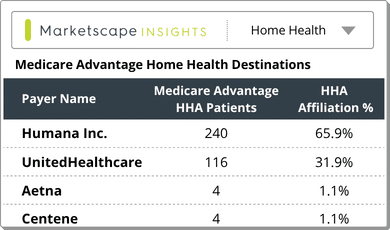Ian Juliano, Chief Executive Officer
Few people have more experience in the healthcare technology and data analytics sectors than Ian Juliano, a vocal proponent for a more efficient and transparent healthcare industry. Prior to founding Trella Health, Ian was CEO of HomecareCRM (HCRM), a census growth platform for the Post-Acute Care (PAC) industry. During Ian’s tenure, HCRM doubled its recurring revenue within five quarters. He also engineered the successful sale of HCRM to SigmaCare, a VC-backed PAC IT provider. Through the University of Pennsylvania dual degree program, Ian earned bachelor’s degrees in business and psychology from the Wharton School and the College of Arts and Sciences, respectively. He also holds an MBA from the Kellogg Graduate School of Management, and he earned academic honors at both institutions.Post-Acute Industry Trends: Q2 2019 to Q2 2020
By Ian Juliano | February 5, 2021
In the past few months, I have been absolutely amazed by the entire healthcare industry’s resilience and strength. Many in our industry have faced unheard of obstacles and setbacks, but those challenges led to a new wave of innovation, allowing many of you to create a new path to normalcy.
And it’s that spirit of innovation and support of this fantastic industry that has inspired our team to make the improvements and enhancements we have made over the past year. From launching Marketscape Strategy, our new network management solution for Accountable Care Organizations (ACO) and Direct Contracting Entities (DCE), to gaining access to Medicare Advantage (MA) data, we’ve worked hard to increase the transparency and visibility into your markets’ trends.
I’m excited to announce the official launch of our 2020 Industry Trend Report. In addition to our usual breakdown of the changes and trends we’ve seen in the industry, this year’s report will also explore initial insights into the impact of COVID-19. For many metrics, we compared Q1 and Q2 2019 to Q1 and Q2 2020. Some of the key takeaways are:
- The balance of fee-for-service (FFS) and Medicare Advantage continues to shift:
- MA penetration continued to grow, eclipsing 40% of all Medicare beneficiaries in Q4 2020.
- While Medicare FFS enrollment increased in 2019 – from 37.6M in Q1 to 38.2M in Q4 – FFS enrollment decreased slightly in 2020 – from 37.1M in Q1 to 36.9M in Q4.
- FFS home health admissions have sharply declined since 2018 while adherence rates continued to impact patient outcomes:
- Home health admissions decreased 5.2% year-over-year in Q1 2020. This could be due to a decline in overall FFS beneficiaries, a lower rate of home health referrals, and a reduced number of elective surgeries at the beginning of the pandemic.
- Patients who did not adhere to home health instructions following an inpatient stay were 26% more likely to be readmitted within 30 days than those who adhered.
- Skilled nursing facilities experienced the most significant impact from COVID-19:
- The effect of the pandemic on skilled nursing admissions is well documented, with a national year-over-year admission decline of 21.4%.
- Despite the reduced admissions, Medicare Average Length of Stay (ALOS) for SNF patients increased 10.5% quarter-over-quarter to 26.3 days in Q2 2020.
- However, other care settings were also impacted:
- At 48.9%, nearly half of all inpatient stays for the Q2 2020 reporting period did not include post-acute care instructions. This represents a slight increase from the 47.8% of episodes that were not referred to PAC during the Q1 2019 reporting period.
- COVID-19 had the third-highest two-year inpatient mortality rate, at 9.8%, exceeded only by neoplasms and sepsis.
- Increased concern and awareness of COVID-19 led to new regulations and waves of innovation in the healthcare community:
- The Centers for Medicare & Medicaid Services (CMS) eased regulations for practicing telehealth, partially mitigating a large gap in healthcare delivery, as in-person physician visits were significantly restricted.
- Telehealth claims rose, as was anticipated, but far outpaced expectations by skyrocketing 3334% year-over-year in April.
The state of post-acute care – and healthcare in general – is likely to be changed forever in the wake of COVID-19. While the full depth of the pandemic’s impact is still unknown, we will continue reporting as new data becomes available. What lasting consequences can we anticipate? Will the rise in telehealth continue as a method to securely – and safely – treat patients in the comfort of their own homes? Will we see an increase in post-acute discharge instructions for home health and a subsequent rebound in admissions, given the increased awareness of the care setting in the second half of 2020? And how will this impact the traditional FFS model? Hospitals, in particular, were decimated financially by the loss of many elective FFS procedures, while capitated MA plans were far better positioned to weather the pandemic. Will COVID-19 hasten the migration to value-based care?
The state of post-acute care – and healthcare in general – is likely to be changed forever in the wake of COVID-19. While the full depth of the pandemic’s impact is still unknown, we will continue reporting as new data becomes available.
Ian Juliano, Trella Health CEO
These are just a few of the questions we’re committed to investigating now and in the future. As always, we strive to deliver the most impactful and accurate insights to our customers so that you may, in turn, improve the state of healthcare in our nation. I look forward to hearing your feedback on this report and would love to know how we can iterate on it in the future to deliver even more value.
Thank you for everything you do – and thank you for partnering with Trella in our quest to create meaningful change in healthcare.
Sincerely,

Ian Juliano
CEO, Trella Health
Download the full Industry Trend Report to learn more.
Have feedback for the team or ideas for future topics we can cover? Send a note to [email protected]













